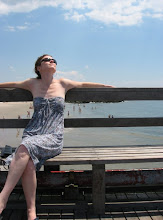Wednesday, July 28th
We arrived into Plaza Sur island with a huge cloud of fog and mist overhead. The island was tiny; you could walk from one end to the other within 10 minutes. Plaza Sur was so absolutely beautiful. The island was speckeled with red and orange plants that mirrored the colors of the sunset. In addition to the colorful plants, the island was filled with these crazy cactus trees called opuntia. The "tree" stood about 15 or 20 feet tall and they all produced fruits called prickly pears. Upon embarking the island we saw numeorus land iguanas. One of the iguanas was chowing down on a prickly pear cactus fruit. It was hilarious to watch becuase the fruit was way bigger than the size of his mouth and he was trying to swallow it whole. After many attempts to swallow it, the iguana eventually got it down his throat without chewing it. On this island there is also the only hybrid iguana found in all of Galapagos. It's a cross breed between a marine and land iguana. Because it is a hybrid iguana, it can live and eat like both species. Sadly, however, it cannot breed at all because they are all infertile (only 4 of them exsist). This iguana looks like a little gremlin and is much darker in color than the other two species.
Here on this island was also a breeding colony of sea lions, a plethora of petrels, pelicans, the famous "red-rimmed eye" swallow tailed gulls. This island was my favorite so far; from the topography to the colors to the wildlife.
Next, we sailed during the day for 3 hours to Puerto Ayora on Santa Cruz. This city is the major hub for tourists and locals alike. From Puerto Ayora we drove to a giant tortoise reserve named el chato. The reserve had loads of giant tortoises, ones so big
I could ride them in the Kentucky Derby. Each tortoise weighs anywhere between 200 and 400 pounds. You could tell the age of the tortoise by looking at how smooth its shell was (the smoother the shell the older it was). Our guide, John, told us that the oldest living animal in the world was a Galapagos tortoise that eventually died at the youthful age of 173 years old. After dismounting my shell of speed, we left the reserve and headed to a research station called the Darwin station. There we saw more tortoises, and land iguanas. The highlight of the Darwin station is a giant tortoise named "Lonely George." The reason for the "lonely" title in his name is becuase he is the only one left of his kind. Numerous scientists have tried to figure out a way to get George to breed. One major part of the problem is that he had no sex drive. John told us a story about a Dutch scientist who came to the Galapagos to study George's breeding habits. After some time she figured out a way to (I'm not kidding when I say this) electronically stimulate his penis. She, the scientist, was at it for 3 years and was unsuccessful. The only reason the project was haulted was because her visa ran out and she had to go back to Holand. A few years ago, George did in fact mate with a few females but all of his sperm were infertile. So sadly when George dies, he'll take his entire species with him as well. After talking about all this tortoise sexy time we got back on the boat and laughed about the day. Again, we were setting sail around midnight to travel to an island called Rabida.
Thursday, August 12, 2010
Subscribe to:
Post Comments (Atom)


No comments:
Post a Comment